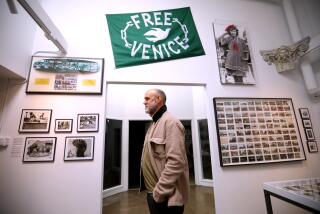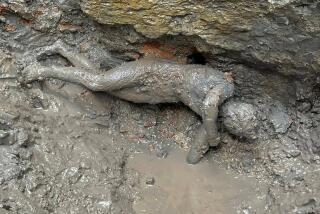Digs show what big wigs dug
- Share via
Pompeii wasn’t the only town to be interred in the ashes of Italy’s Mt. Vesuvius. The volcanic eruption of AD 79 buried an entire region, including the luxury resort of Stabiae, an ancient high-rent district where rich and powerful Romans escaped the summer heat in lavish seaside villas.
Excavations of the area (present-day Castellammare di Stabia) have taken place off and on from the 18th century to the present day. These have brought forth all manner of artifacts -- including striking frescoes painted with landscapes, gods and goddesses and scenes of feasting and revelry -- that reveal much about the lives of the movers and shakers who owned them.
Under the auspices of the Italian government, pieces of this treasure trove are touring the United States for the first time. The exhibition, “In Stabiano: Exploring the Ancient Seaside Villas of the Roman Elite,” featuring 2,000-year-old frescoes, stucco reliefs, sculptures and artifacts, has been making its way across the country since opening in 2004 at the Smithsonian’s National Museum of Natural History in Washington.
This week, the exhibition makes its only Southern California stop, opening Saturday at the San Diego Museum of Art. It runs through May 14.
“When we were thinking about how to promote this, it was, well, you know about Pompeii, but do you know about its opulent neighbor?” said Steven Kern, the museum’s curator of European art.
“The interesting thing is what the artifacts reveal about taste, patronage and connoisseurship between the years 89 BC and AD 79. There’s a tremendous amount that we can glean about the Romans and what was of interest to them, [just as] Pompeii revealed what they ate, how they shopped and everything else.”
Organized by the Restoring Ancient Stabiae Foundation and the Superintendency of Archaeology of Pompeii, the exhibition of about 70 objects includes one of the most striking finds: a three-wall dining room, or triclinium, painted with Dionysiac imagery, discovered in the 1950s.
Placing the exhibition in its rich historical context provides an opportunity to see the flow of culture, science, technology and art “from antiquity to the Renaissance to the present,” he said. “It’s just exhilarating.”
*
-- Lynne Heffley
More to Read
Sign up for The Wild
We’ll help you find the best places to hike, bike and run, as well as the perfect silent spots for meditation and yoga.
You may occasionally receive promotional content from the Los Angeles Times.






